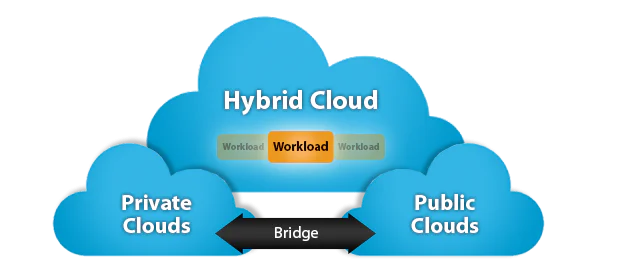
Cloud technology has proven that its benefits are in tune with the buzz it generated a few years back. Many organizations, across the globe, including small and medium businesses have already embraced cloud computing or are planning to adapt it to further boost their business capability.
The adoption rate of cloud has been growing consistently in double digits in the last couple of years. Research firm, IDC states that the global cloud market, including private, public and hybrid cloud, would cross $118 billion in 2015 and crest at $200 billion by 2018. And more interestingly, according to Gartner by 2017, 50% of enterprises would be using “Hybrid Cloud”.
The reason for the industry’s focus on hybrid cloud can be attributed to the shortcomings of both, public and private cloud model. When it comes to cloud, security and scalability are the major concern shown by all companies. Public cloud provides offsite services and infrastructure, enabling scalability and agility at lower costs, but is more vulnerable, in terms of security. On the other hand private cloud offers services and infrastructure on a private network with high level of security, but to achieve the same level of scalability and agility as that of public cloud, the cost factor is pretty high.
Hybrid cloud model, in simple terms, is a blend of private cloud and public cloud as it combines the security of private cloud with the low cost benefits of public cloud. The biggest business advantage hybrid cloud offers to organization is the ability to choose which cloud model suits various parts/modules of their business/application and also gives them the freedom to choose amongst multiple providers.

Cloud vendors offering hybrid model are coming up with new security answers to further boost its benefits. However, security isn’t the only factor to be considered before going hybrid. Hybrid cloud requires significant integration and coordination among the organization’s internal and external environments. There is a need to properly address data, process, management, and security requirements. One has to select the platform for moving to cloud, set service level agreement expectations with the cloud service provider, identify IT assets and classify them into which would go into public, which in a hosted private cloud or remain inside the firm’s data center.
Let’s look at some of the key considerations apart from security one should consider before going hybrid:
- Application architecture
One of the most significant hurdles one can face while moving to hybrid cloud is the incompatibility between your existing IT infrastructure and the public cloud platform. Users expect a seamless interaction and communication between all the assets across the entire network, be it on public cloud or a local data center. To achieve this, organizations can consider re architecting their applications to use in the cloud, which is a major effort. Alternatively, interoperability mechanism provided by some software vendors can be evaluated. Anything short of smooth transition of workloads between data centers (Private and Public), would hamper an organization’s ability to utilize benefits of the cloud to the maximum.
- Data Residency
The second key factor to consider while moving to hybrid cloud would be the location of data, as many times data along with workloads, has to be moved between public and private cloud. Many cloud service providers (CSP) offer hosted private clouds in the same location as the public clouds, thus your application and data can remain in the same location. This is an ideal situation.
But what if the organization wants to move parts of its data from private cloud to public along with the application, and by policy it should be restricted only to a specific region or a country. Moreover certain state laws especially in the European Union (EU) enforce regulations which render confidential data to remain within its borders. Thus one needs to have a keen watch over the location and model of the cloud, where the data can reside and change it as the need arises.
- Policies \Regulatory Compliance Requirement
A business or an individual should not simply reinvent their existing policies when moving to hybrid cloud. The applications and data should be surrounded and governed by the same policies as they would be in the firm’s own data center. For instance, when a Health insurance Portability and Accountability Act (HIPAA) certified application moves to a public cloud to increase its availability to its users, the cloud service provider selected should be able to offer the same level of security measures to ensure compliance with various regulations.
- Network Access
When using hybrid model, the network between public and private cloud plays a vital role. There is always a challenge in manually setting up the network design when moving application to cloud, which can be further escalated due to complexity of the application. It would be good if organizations look for hybrid cloud solutions which can offer to extend your data center configurations and policies. With the use of the same network level configuration, your application will run, as if it were operating in your private data center.
Apart from the above generalized list, a different business requirement might force an organization to ponder on few other considerations as well. But the good part is, today we have good number of cloud service providers in market that consider above factors into their offerings. Looking at the offerings by hybrid model providers in market and its large-scale adoption, year 2015 can be “Year of Hybrid Cloud”.






